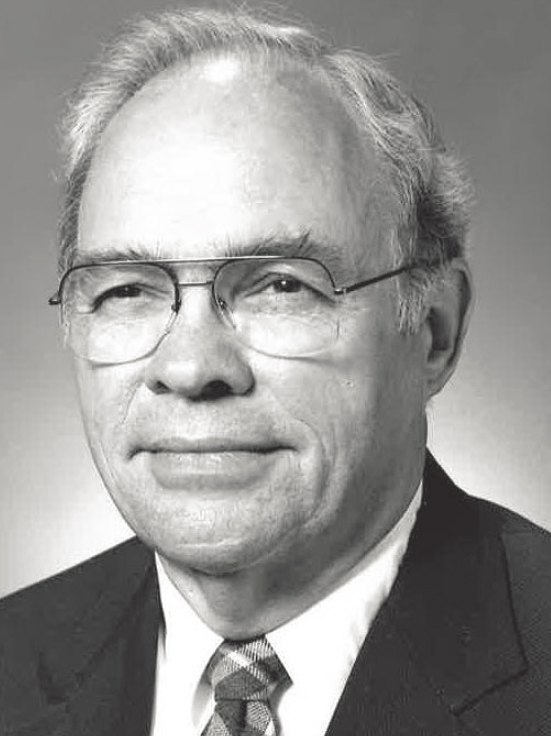
JAMES E. VAN NESS
1926–2016
Elected in 1998
“For computer algorithms used in the design and operation of electric power systems.”
BY ARUN PHADKE AND AMANDA MORRIS
JAMES EDWARD VAN NESS, emeritus professor of electrical engineering and computer science at Northwestern University, passed away at age 90 on September 9, 2016, after a long illness. He was born June 24, 1926, to Hubert and Sarah Van Ness in Omaha and spent his boyhood in Boone, Iowa. He will be remembered as a devoted teacher, valued mentor, and friend.
Professor Van Ness was inspired to pursue electrical engineering after serving in the US Navy, where he spent 2 years working with radar equipment on an aircraft carrier. When his service ended, he earned his BS at Iowa State University (1949) and then his master’s (1951) and PhD (1954) at Northwestern, all in electrical engineering. Before he had even finished his PhD, he joined Northwestern as a lecturer in 1952 and went on to become a full professor.
He made major contributions in the area of large-scale networks, including early computer systems and the power grid. He published path-breaking papers in IEEE Transactions on Power Apparatus and Systems and other publications of note. He was a close associate of the first author, beginning with his contribution to the summer institutes at the University of Wisconsin–Madison. He is best remembered for his work on load flow, a key program used in most engineering applications in power system engineering.
Before Jim published his work on load flow, the commonly used method was to formulate the problem as an iterative approach to find voltages on the network, minimizing variation in voltages as iterations advanced. Although this method provided results in most cases, the procedure was slow to converge to a solution, and often did not do so when the power system was heavily loaded. In 1961 Jim (with his student John H. Griffin) published a paper titled “Elimination Methods for Load-Flow Studies”1 that completely altered the approach to the load flow problem. For the first time, they keyed in on the injection data in the load flow formulation and strived to find a solution to system voltage vector that minimized the residue in the injections. This led to the famous Jacobian matrix formulation, which would converge in a few iterations and could always find a solution (whether or not it was physically realizable).
The process involved the solving of a large dimensional matrix equation, which was greatly simplified by the work published by William Tinney of the Bonneville Power Administration in Portland, Oregon. Van Ness’s and Tinney’s work completely changed the landscape of power system engineering software. Later, Brian Stott built on their work to produce a remarkable simplification of the entire problem as a fast decoupled load flow formulation; it is now the universally accepted method for solving load flow problems in most applications in the power industry.
Professor Van Ness’s work was a driver in bringing high-performance computers to Northwestern in the 1970s—a time when computers were so massive that they required their own buildings. He became a fellow of the Institute of Electrical and Electronics Engineers in 1981 for his contributions to research and education in computer analysis of power systems, and his pioneering work led to his NAE election in 1988. He was also a member of Eta Kappa Nu, Tau Beta Pi, Sigma Xi, and the Association of Computing Machinery.
________________
1 In Transactions of the American Institute of Electrical Engineers 80(3):299–302.
Jim had a sparkling sense of humor. He would pepper his lectures with anecdotes and accounts of personal contacts with scholars such as Edward Kimbark, who also had worked at Northwestern University. His humorous stories were often self-deprecating; for example, one day a student came to him after class about a joke Jim had told during the lecture. The student said that his father had taken Jim’s class some years ago—and that he had told the very same joke back then.
“Jim was truly a gentleman and a scholar,” said Alan Sahakian, chair and professor of Northwestern’s Department of Electrical Engineering and Computer Science. “He was very modest and down-to-earth in spite of his many accomplishments and distinctions.”
My (first author’s) son Ajit attended Northwestern starting in 1989, and Jim and his wife Mary Ellen looked after him most kindly, including hosting him for meals at their home near campus.
With the exception of brief stints as a visiting professor at the University of California at Berkeley and Massachusetts Institute of Technology, Jim spent his career at Northwestern. He was director of the computing center (1962–65) and chair of the EECS Department (1969–72).
Although his research into power systems earned him international recognition, Jim most valued teaching and spending time with his students. He also enjoyed music, gardening, travel, photography, history books, and trains.
James Van Ness is survived by his wife of 67 years, Mary Ellen (née Dolvin); daughters Becky, Barb, Meg, and Julie; and five grandchildren and one great-grandchild.




